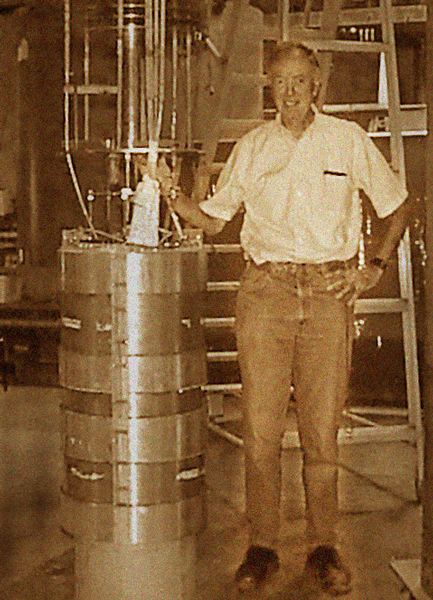Clyde Taylor, a pioneer of superconducting magnet technology at both Lawrence Livermore and Lawrence Berkeley National Laboratories, died suddenly on November 16 at the age of 80.
Clyde was born December 5, 1930, in Susanville, CA, and attended Stanford University, where he majored in engineering and where he met his wife to be, Ruthann Person, at a fraternity dance. He received his B.S. in 1952, and just two weeks after graduation he and Ruthann were married. Clyde stayed at Stanford another year for his M.S. in Mechanical Engineering, and then the couple moved to Ventura, where Clyde became Chief Drilling Engineer for Shell Oil Company’s West Coast Operations.
In 1956 Clyde began his work in superconducting magnets at Lawrence Livermore Lab, rising to become assistant director of the Lab’s magnetic confinement fusion program. He was active in Livermore community affairs and served on planning commissions and the city council, before being elected mayor of Livermore.
Livermore Lab’s fusion program at the time focused on mirror machines, in which plasma was confined by increasing gradients along magnetic field lines. Such machines required superconducting materials that could remain stable at very low temperatures while carrying very high currents and generating high magnetic fields. Livermore’s Jon Zbasnik recalls that, as part of the effort to build the Fusion Engineering Research Facility, and later the Mirror Fusion Test Facility – for which Clyde developed the “yin-yang” magnet configuration – he initiated research on niobium-tin, a superior superconducting material but one difficult to work with, which is still at the leading edge of superconducting magnet technology.
Clyde left Livermore in 1981 to join Berkeley Lab as head of the Supercon Group in the Accelerator and Fusion Research Division (AFRD), often working closely with Shlomo Caspi of Berkeley Lab’s Engineering Division. Clyde became head of the multilab engineering team that won the magnet design competition for the Superconducting Super Collider (SSC), whose planning efforts were based at Berkeley Lab. The SSC was canceled in 1993, but Caspi recalls that Clyde’s engineering skills and talent for management had led DOE to recognize AFRD’s strong position and unique analytical skills in the superconducting magnet field.
Clyde renewed his interest in niobium-tin as essential for advanced magnets when he led AFRD research toward achieving extraordinarily strong magnetic fields, beyond 10 tesla; he designed the first magnet to use windings of the material, according to Ron Scanlan, who in 1994 traded roles with Clyde and became supervisor of AFRD’s magnet group. The niobium-tin magnet they built achieved 13.6T in 1997, still a record. Today, similar magnets play an important role in AFRD’s designs for the planned Large Hadron Collider upgrade. During those years Clyde also put in place a special cabling machine at AFRD, which served as a prototype for industry and continues to supply cable to several DOE labs today.
At this time, as Scanlan recalls, Clyde also developed a solution to a major problem limiting the performance of accelerator magnets: the movement of structural elements under the tremendous forces generated by the magnets themselves, which can lead to disastrous “quenches.” His solution was a system of keys and bladders filled with liquid metal to prestress critical components. Refined by Shlomo Caspi, the bladder and key design made possible a series of record-breaking superconducting magnets built at Berkeley Lab.
Beginning in 1995, Clyde developed the “superbend” insertion devices that allowed the Advanced Light Source, built to optimize soft x-ray production, to extend operations well into the hard x-ray region, a requirement for protein-crystallography beamlines that are among the ALS’s most productive, according to AFRD’s Alan Jackson. Developed in cooperation with an industrial firm, Wang NMR, the Superbends are unique to the ALS among the world’s synchrotron light sources, which now has several of them.
Also in 1995, Clyde applied the bladder and key concept to his design for the superconducting magnet structure of a new kind of ion source for the 88-Inch Cyclotron, proposed by Claude Lyneis of the Nuclear Science Division. Called VENUS (“versatile ECR ion source for nuclear science”), the new source would be capable of producing high currents of ions, from hydrogen all the way to uranium, but required the highest magnetic fields ever achieved in this kind of ion source. Lyneis notes that the outstanding performance of VENUS, completed in 2003, was a key factor in enabling the rare ion beam facility now under construction at Michigan State University.
Clyde continued to work on both the Superbends and VENUS after his 1996 retirement and subsequent rehire as a consultant, continuing part time at the Lab until 2008. His lifelong enthusiasm for long-distance bicycle trips, backpacking, and cross-country skiing continued, as did his passion for travel abroad and for theater.
Clyde is warmly remembered by his many associates over the years as “a true gentleman” (Alan Jackson); “a very sincere, very kind, and very warm person, with great devotion to his work” (Bert Wang); “my mentor, supervisor, and friend for over 25 years, and one of the best people I have known” (Ron Scanlan); “a gentle person, soft-spoken and a great traveling companion [who] liked people and was eager to help, especially young people at the beginning of their career” (Shlomo Caspi); and many others, including Claude Lyneis, who organized this remembrance.
Clyde Taylor is survived by his wife, Ruthann; his daughter Anna Brewer and her husband, Nate, of Denver; his son Clyde B. and his wife Dona, of Moraga; his daughter Carol Abas and her husband, Coenraad; and seven grandchildren.
